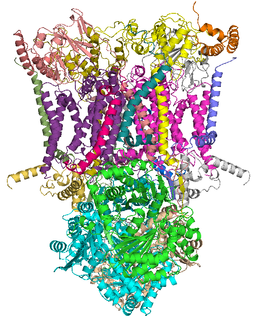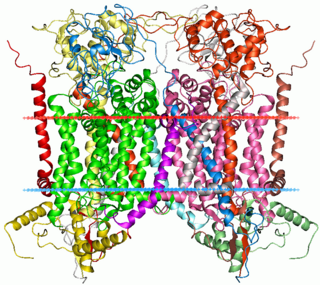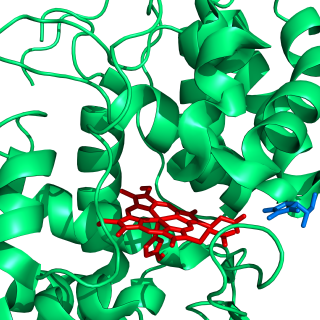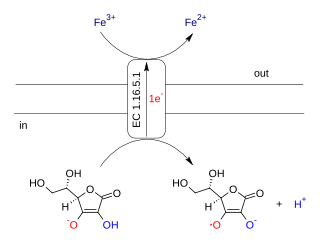Related Research Articles

The coenzyme Q : cytochrome c – oxidoreductase, sometimes called the cytochrome bc1 complex, and at other times complex III, is the third complex in the electron transport chain, playing a critical role in biochemical generation of ATP. Complex III is a multisubunit transmembrane protein encoded by both the mitochondrial and the nuclear genomes. Complex III is present in the mitochondria of all animals and all aerobic eukaryotes and the inner membranes of most eubacteria. Mutations in Complex III cause exercise intolerance as well as multisystem disorders. The bc1 complex contains 11 subunits, 3 respiratory subunits, 2 core proteins and 6 low-molecular weight proteins.

Sodium ascorbate is one of a number of mineral salts of ascorbic acid (vitamin C). The molecular formula of this chemical compound is C6H7NaO6. As the sodium salt of ascorbic acid, it is known as a mineral ascorbate. It has not been demonstrated to be more bioavailable than any other form of vitamin C supplement.

Cytochrome b is a protein found in the mitochondria of eukaryotic cells. It functions as part of the electron transport chain and is the main subunit of transmembrane cytochrome bc1 and b6f complexes.

Ascorbate peroxidase (or L-ascorbate peroxidase, APX) (EC 1.11.1.11) is an enzyme that catalyzes the chemical reaction

Duodenal cytochrome B (Dcytb) also known as cytochrome b reductase 1 is an enzyme that in humans is encoded by the CYBRD1 gene.

Cytochrome-b5 reductase is a NADH-dependent enzyme that converts ferricytochrome from a Fe3+ form to a Fe2+ form. It contains FAD and catalyzes the reaction:
Cytochrome P450 reductase is a membrane-bound enzyme required for electron transfer from NADPH to cytochrome P450 and other heme proteins including heme oxygenase in the endoplasmic reticulum of the eukaryotic cell.
Ecdysone 20-monooxygenase (EC 1.14.99.22) is an enzyme that catalyzes the chemical reaction
In enzymology, a carbon-monoxide dehydrogenase (cytochrome b-561) (EC 1.2.2.4) is an enzyme that catalyzes the chemical reaction

NADH-cytochrome b5 reductase 3 is an enzyme that in humans is encoded by the CYB5R3 gene.

In enzymology, a NADPH—hemoprotein reductase (EC 1.6.2.4) is an enzyme that catalyzes the chemical reaction

Cytochrome b is a protein that in humans is encoded by the MT-CYB gene. Its gene product is a subunit of the respiratory chain protein ubiquinol–cytochrome c reductase, which consists of the products of one mitochondrially encoded gene, MT-CYB, and ten nuclear genes—UQCRC1, UQCRC2, CYC1, UQCRFS1, UQCRB, "11kDa protein", UQCRH, Rieske protein presequence, "cyt c1 associated protein", and Rieske-associated protein.

Cytochrome b561 is a protein that in humans is encoded by the CYB561 gene.

Cytochrome b5 reductase 4 is an enzyme that in humans is encoded by the CYB5R4 gene.

NADH-cytochrome b5 reductase 1 is an enzyme that in humans is encoded by the CYB5R1 gene.

Cytochrome b5 reductase 2 is an enzyme that in humans is encoded by the CYB5R2 gene.
The oxidoreductase FAD-binding domain is an evolutionary conserved protein domain.
Oxidoreductase NAD-binding domain is an evolutionary conserved protein domain.
Abieta-7,13-dien-18-ol hydroxylase (EC 1.14.13.109, CYP720B1, PTAO) is an enzyme with systematic name abieta-7,13-dien-18-ol,NADPH:oxygen oxidoreductase (18-hydroxylating). This enzyme catalyses the following chemical reaction

Ascorbate ferrireductase (transmembrane) is an enzyme with systematic name Fe(III):ascorbate oxidorectuctase (electron-translocating). This enzyme catalyses the following chemical reaction
References
- ↑ Cytochrome b561, Uniprot
- ↑ Lu P, Ma D, Yan C, Gong X, Du M, Shi Y (February 2014). "Structure and mechanism of a eukaryotic transmembrane ascorbate-dependent oxidoreductase". Proceedings of the National Academy of Sciences of the United States of America. 111 (5): 1813–8. Bibcode:2014PNAS..111.1813L. doi: 10.1073/pnas.1323931111 . PMC 3918761 . PMID 24449903.